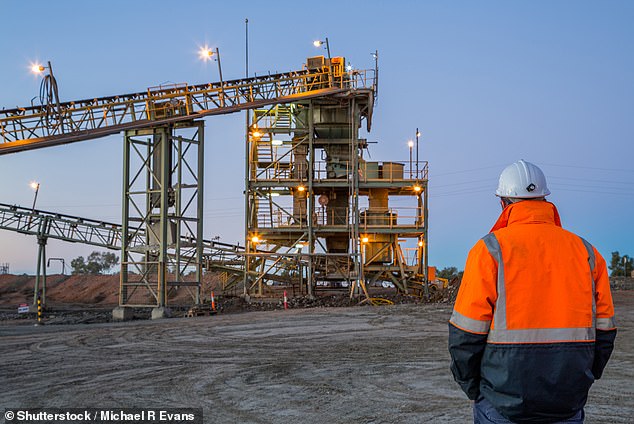
London-listed mining shares fell sharply after Antofagasta and BHP Group revealed significant profit slumps on the back of higher costs and lower commodity prices.
Chilean miner Antofagasta saw a 39 per cent fall in full-year profit to $2.9billion (£2.4billion), as high input costs, reduced copper output volumes, and a drought in the South American country hit production.
Meanwhile BHP, which is the world’s largest miner, reported a steeper-than-expected 32 per cent fall in first-half profit, owing to a drop in iron ore prices.
BHP Group shares fell 2.7 per cent per cent, while Antofagasta shares slipped 2.6 per cent in early trading, dragging peers and the FTSE 350 mining index 2.2 per cent lower.

Copper and other commodities saw double-digit price falls in the last financial year
It reverses gains made by FTSE 350 miners on Monday when investors eyed a recovery in Chinese demand for metals like copper and aluminium.
Both BHP and Antofagasta echoed this optimism in their results on Tuesday, but this was not enough to reignite investor optimism after earnings disappointed.
Adam Vettese, analyst at eToro, said: ‘Looking forward, China’s decision to relax its stance on Covid is a boon for miners, which rely on its insatiable appetite for metals.
‘The fact many economists are now predicting that the US and Europe will have a shallower recession – or even avoid one altogether – should also be supportive of metal prices.’
BHP posted underlying profit attributable from continuing operations of $6.6billion (£5.5billion) during the half, down from $9.72billion a year earlier, and missing estimates of $6.82billion.
The group saw revenues fall $4.8billion during the period to $25.7billion, which it said ‘largely reflects lower iron ore and copper prices’.
Capital and exploration expenditure also jumped 5 per cent to around $3billion, while BHP paid $7.5billion in taxes and royalty payments.
BHP chief executive Mike Henry highlighted ‘significant wet weather in our coal assets’, as well as ‘challenges in securing sufficient labour’, and ‘inventory movements’ as contributing to rising costs over the half.
However, he noted ‘BHP remains the lowest cost major iron ore producer globally’ and said the group ‘continued to make strong progress on executing our strategy, including the development of growth options’.
Net debt rose 13 per cent to $6.9billion, but BHP said this was ‘towards the bottom of our target range of between $5billion and $15billion’.
BHP is set to pay an interim dividend of $0.90 per share, or $4.6billion in total, equivalent to a 69 per cent payout ratio.
Going forward, Henry said BHP is ‘positive about the demand outlook’ in the second half of 2023 and into 2024, ‘with strengthening activity in China on the back of recent policy decisions the major driver’.
He added: ‘We expect domestic demand in China and India to provide stabilising counterweights to the ongoing slowdown in global trade and in the economies of the US, Japan and Europe.
‘The long-term outlook for our commodities remains strong given population growth, rising living standards and the metals intensity of the energy transition, including for steel making raw materials.’
Despite Tuesday’s decline, the firm’s shares have still added 8.3 per cent in 2023 so far. It is up more than 160 per cent since the bottom of the March 2020 Covid sell-off, reflecting soaring commodity prices over that period.
However, commodities prices have begun to stabilise and, in some cases, started to fall.
Antofagasta was forced to more than halve its annual dividend after a record payout of $1.425 per share in 2021, following a fall in copper prices over its financial year.
Revenue in 2022 was $5.8billion, 22 per cent lower than in 2021, reflecting the fall in copper sales volumes and prices, which both fell by 12 per cent.
The firm’s copper production also fell 10.4 per cent over the period as a result of drought and ‘reduced concentrate pipeline availability’, it said, while gold and essential trace metal molybdenum output fell 29.9 and 7.6 per cent, respectively.
But Antofagasta reiterated it expects copper production to rise through 2023, helped by the relaxation of Covid-19 curbs in China and a growing shift towards green energy.
Net cash costs climbed 34.2 per cent ‘due to higher cash costs before by-product credits’, the group added.
Chief executive Iván Arriagada said: ‘Copper and by-product production is expected to increase over the course of 2023 and we expect cash costs before by-product credits to remain in line with 2022.
‘All this is supported by copper’s fundamentals which remain strong, with China showing signs of recovery and with the energy transition underpinning the long-term demand for copper.
‘In line with our dividend policy, the Board has recommended a final dividend of 50.5 cents per share, to be approved by shareholders at the AGM, which brings the total dividend for the year to 59.7 cents per share, equivalent to a pay-out ratio of 100 per cent, reflecting our positive outlook for 2023.’









